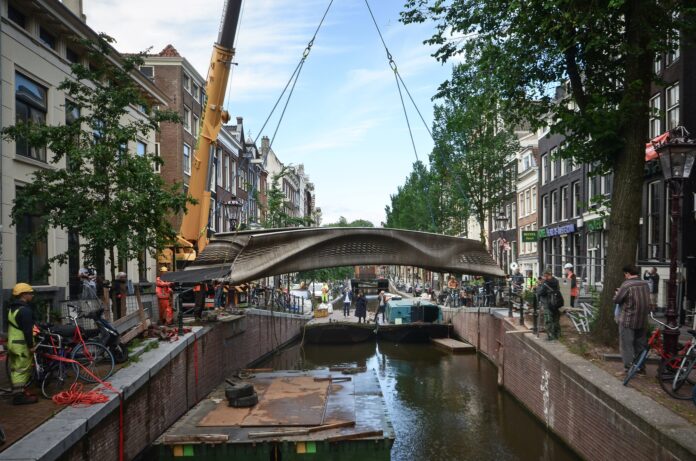Additive manufacturing, also known as 3D printing, has moved well beyond the novelty stage. Today NASA, SpaceX, Blue Origin, General Motors and other advanced manufacturers have incorporated the technology into their production lines.
But just how good can finished products made this way be when asked to hold up to real-world applications?
That’s what the designers and builders of the world’s first 3D-printed steel bridge want to find out. They have created a living laboratory and will see it installed today over the Oudezijds Achterburgwal canal in Amsterdam’s Red Light District where it will serve pedestrian traffic.
It took four years for the Dutch company MX3D to print the bridge which has been ensconced in the city centre of Amsterdam. The Imperial College London and The Alan Turing Institute team designed the bridge incorporating a vast network of installed sensors to monitor and analyze the performance of the 12-metre-long (almost 40 feet) structure. Data collected will measure the bridge’s structural and operational health in real-time and over its lifespan.
A digital twin of the bridge will receive and share the data to provide performance analysis to answer questions about the long-term behaviour of 3D-printed steel, as well as its use in real-world settings.
Professor Leroy Gardner of the Department of Civil and Environmental Engineering at Imperial College at the unveiling of the bridge in Amsterdam stated, “A 3D-printed metal structure large and strong enough to handle pedestrian traffic has never been constructed before. We have tested and simulated the structure and its components throughout the printing process and upon its completion, and it’s fantastic to see it finally open to the public.”
Dr. Craig Buchanan, also of Imperial College noted, “Research into this new technology for the construction industry has huge potential for the future, in terms of aesthetics and highly optimized and efficient design, with reduced material usage.”
Gardner and Buchanan are co-contributors on the project and have been supported by a team of undergraduate and postgraduate students, Ph.D. candidates, post-doctoral researchers and laboratory technicians. The team’s work has been predominantly funded by The Alan Turing Institute, with additional money coming from the Engineering and Physical Sciences Research Council, part of UK Research and Innovation.
Printing steel and other metals is a relatively new manufacturing process. SpaceX, Elon Musk’s company uses it to make flight hardware for its Dragon capsules. Its SuperDraco engine chamber is made of Inconel, a high-performance super-alloy and is built using direct metal laser sintering. Another rocket builder, Relativity Space has developed its own 3D-metal printer it calls Stargate. It is being used to build the Terran 1 rocket entirely manufactured using 3D printing.
For the bridge builders, the absence of structural design knowledge on how 3D-printed steel performs led to an ambitious research programme using small-scale destructive material and cross-section testing, computer modelling and large-scale non-destructive real-world testing.
Gardner in a press release put out by The Imperial College today notes, “3D printing presents tremendous opportunities to the construction industry, enabling far greater freedom in terms of material properties and shapes. This freedom also brings a range of challenges and will require structural engineers to think in new ways.”
How so? The challenges include studying the same things that all bridge builders encounter. How will the bridge handle varying loads? How will the printed microstructure endure constant usage?
The use of a digital twin, to be monitored by both Imperial College researchers and a team at The Alan Turing Institute, is seen as a significant innovation for accelerating the design, testing, and monitoring process over the lifetime of the installed structure. The researchers should learn a lot as the embedded sensors share what is happening in the real-world daily usage of the structure with the computer version. Professor Mark Girolami at Turing heads up the digital twin program studying data-centric engineering. The data captured from the bridge will be made available to other researchers worldwide who want to work with the Turing researchers in analyzing it.









